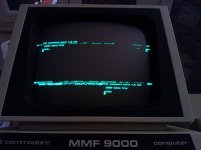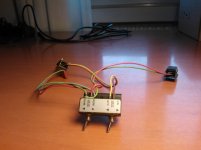Gabriele72
Experienced Member
I'm back to vintage computing after a while, and decided to take a look at a MMF9000 SuperPET that's been sitting in a corner reclaiming attention for years.
The SuperPET is a heavily expanded 8032, and (to start with) the mainboard was completely dead.
After fixing some bad RAMs I was welcomed with the beep and a screen full of blocks. I noted that /CS2 on the char EPROM was being held high. Since it's driven driven directly by the 6545 I desoldered and replaced the CRTC.
Great improvement, but my joy was quickly shattered as I was left with this screen:

The boot message is doubled (or tripled) and misplaced, and enlarged ghost chars appear as you type.
Tried 3 different 6545s so the problem should not be the controller.
I tend not to blame the video RAM either, as I can poke and peek correctly from location 32768 to 34768.
That should be the end of the video memory (2000 locations) right? But if I go on pokeing beyond that address I can see that line of weird characters at bottom that gets overwritten.
Beyond that, evertything seems fully functional.
I don't have a scope or a logic analyzer, only a multimeter and a couple of logic probes.
What to check next...?
The SuperPET is a heavily expanded 8032, and (to start with) the mainboard was completely dead.
After fixing some bad RAMs I was welcomed with the beep and a screen full of blocks. I noted that /CS2 on the char EPROM was being held high. Since it's driven driven directly by the 6545 I desoldered and replaced the CRTC.
Great improvement, but my joy was quickly shattered as I was left with this screen:

The boot message is doubled (or tripled) and misplaced, and enlarged ghost chars appear as you type.
Tried 3 different 6545s so the problem should not be the controller.
I tend not to blame the video RAM either, as I can poke and peek correctly from location 32768 to 34768.
That should be the end of the video memory (2000 locations) right? But if I go on pokeing beyond that address I can see that line of weird characters at bottom that gets overwritten.
Beyond that, evertything seems fully functional.
I don't have a scope or a logic analyzer, only a multimeter and a couple of logic probes.
What to check next...?

